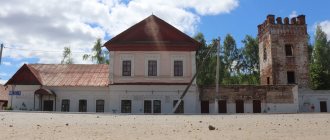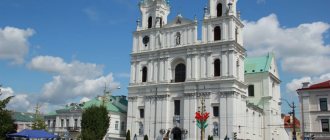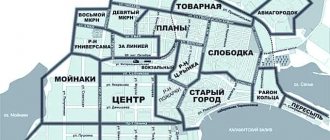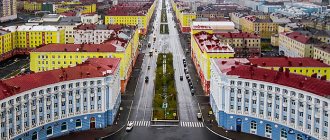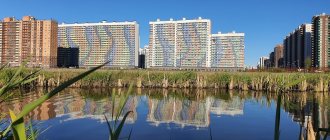For other uses, see Dudinka (disambiguation).
City in Krasnoyarsk Krai, Russia
| Dudinka Dudinka | |
| City [1] | |
| Other transcription(s) | |
| • Nenets | Tut'yn |
| • Dolgan | ? Dudinka? |
| Clockwise: Dudinka port, aerial view of Dudinka; House of Culture | |
| Flag Coat of arms | |
| Location of Dudinka | |
| Dudinka Location of Dudinka Show map of Russia Dudinka Dudinka (Krasnoyarsk region) Show map of Krasnoyarsk Territory | |
| Coordinates: 69°24'N 86°11'E / 69.400°N W. 86.183°E / 69,400; 86.183 Coordinates: 69°24'N 86°11'E. / 69.400°N W. 86.183°E / 69,400; 86.183 | |
| A country | Russia |
| Federal subject | Krasnoyarsk region [1] |
| Administrative region | Taimyr Dolgano-Nenets district [1] |
| District city | Dudinka [1] |
| Based | 1667 |
| City status from | 1951 |
| Square | |
| • General | 10.5 km2 (4.1 sq mi) |
| Height | 20 m (70 ft) |
| population size (2010 Census) [2] | |
| • General | 22 175 |
| • Evaluate (2018) [3] | 21 015 ( -5,2% ) |
| • Density | 2,100/km2 (5,500/sq mi) |
| Administrative status | |
| • Capital from | Taimyr Dolgano-Nenets district [1], district town of Dudinka [1] |
| Municipal status | |
| • Municipal district | Taimyr Dolgano-Nenets municipal district [4] |
| • Urban village | Urban settlement Dudinka [4] |
| • Capital from | Taimyrsky Dolgano-Nenets municipal district [4], Dudinka urban-type settlement [4] |
| Timezone | UTC+7 (MSK+4[5]) |
| Postal code [6] | 647000 |
| Dial code(s) | +7 39191 |
| OKTMO ID | 04653101001 |
| Web site | www.gorod-dudinka.ru |
Dudinka
(Russian: Dudinka, Nenets: Tut'yn) is a city on the Yenisei River and the administrative center of the Taimyr Dolgano-Nenets Okrug in Krasnoyarsk Krai, Russia. Previously, it was the administrative center of the Taimyr Autonomous Okrug, which was annexed to the Krasnoyarsk Territory on January 1, 2007. Population: 22,175 (2010 census); [2] 25,132 (2002 census); [7] 32,325 (1989 census).[8]
Economics [edit]
Dudinka processes and sends cargo via the Norilsk Railway to the Norilsk Mining and Metallurgical Combine, and also ships non-ferrous metals, coal and ore. In 1969, the Messoyakha -Dudinka-Norilsk natural gas pipeline was laid.
Port of Dudinka
Dudinka is a port in the lower reaches of the Yenisei, accessible to sea vessels. The city is served by Dudinka Airport.
Infrastructure[edit]
Chaika mast in Dudinka
Near Dudinka there is a 462-meter (1,516 ft) high radio mast that was formerly used for the "Chaika" radio navigation system. This is a grounded mast with a rhombic lattice antenna. [10]
Bright, expensive, large-scale
If you don’t have friends who can shelter you, don’t despair - there are three hotels in Dudinka. For 2500 rubles (average price per day) do not expect luxury. This is a ticket back to the past, the situation there is a natural Soviet of the 90s (and if you’re unlucky, then even more ancient mansions). And yes, for an hour of using wi-fi they will charge you around 300 rubles.
You can also rent an apartment daily. Even for a thousand and a half. But get ready that it will be in unknown condition and, perhaps, even without a kitchen. And if such living conditions begin to make you depressed, think that, for example, travelers Fridtjof Nansen, Khariton Laptev and Nikolai Urvantsev once lived in Dudinka in much worse conditions. And without the Internet.
If you are lucky enough to come to Dudinka in the summer and you are not afraid of midges, then you can just take a walk around the city. Moreover, the houses, which are intricately “stuck” at different heights, were painted in cheerful rainbow colors. The facades had been colored before, but during my visit I saw buildings of such dirty shades that the whole city looked like one huge, shabby mental hospital.
The port occupies a special place. This is Dudinka’s “breadwinner”. After all, for his sake, in fact, the city was founded. You can't help but go to the port! You can sit comfortably on a bench on the shore and watch the work in full swing here. Tower cranes load containers onto huge orange icebreakers - the scale of the action immediately amazes the inexperienced viewer. And all this happens to the cry of polar gulls. And if you're lucky, you'll be able to see military vessels going out for exercises. Great, isn't it?
And walk along the summer Dudinka at night - this, of course, is not St. Petersburg, baby, but it is light, like in the Northern capital. Polar day.Climate[edit]
Despite the fact that Dudinka is located more than one and a half degrees above the Arctic Circle, it has a subarctic climate ( Köppen climate classification Dfc
) with short mild summers and severely cold winters. Precipitation is moderate; falls mostly as rain in the summer and mostly as snow the rest of the year.
| Climate data for Dudinka | |||||||||||||
| Month | Jan | Feb | Mar | Apr | May | Jun | Jul | Aug | Sep | October | But I | December | Year |
| Record high °C (°F) | -0,3 (31,5) | -0,6 (30,9) | 4,2 (39,6) | 8,8 (47,8) | 26,5 (79,7) | 31,2 (88,2) | 32,3 (90,1) | 30,0 (86,0) | 24,5 (76,1) | 12,3 (54,1) | 2,7 (36,9) | 0,7 (33,3) | 32,3 (90,1) |
| Average high °C (°F) | -22,7 (-8,9) | -22,3 (-8,1) | -15,8 (3,6) | -9,3 (15,3) | -1,1 (30,0) | 11,1 (52,0) | 19,1 (66,4) | 15,8 (60,4) | 7,4 (45,3) | -4,8 (23,4) | -16,3 (2,7) | -21,1 (-6,0) | −5 (23) |
| Daily average °C (°F) | -26,9 (-16,4) | -26,6 (-15,9) | -21,2 (-6,2) | -15,1 (4,8) | −5 (23) | 6,7 (44,1) | 13,8 (56,8) | 11,2 (52,2) | 4,0 (39,2) | -7,9 (17,8) | -20,5 (-4,9) | -25,1 ( -13,2 ) | -9,4 (15,1) |
| Average low °C (°F) | -31 (-24) | -30,8 (-23,4) | -26 (-15) | -20,2 (-4,4) | -8,5 (16,7) | 3,3 (37,9) | 9,5 (49,1) | 7,6 (45,7) | 1,4 (34,5) | -10,9 (12,4) | -24,7 (-12,5) | -29,3 (-20,7) | −13,3 (8,1) |
| Record low °C (°F) | -56,7 (-70,1) | -55 (-67) | -52,1 (-61,8) | -45,4 (-49,7) | -32,6 (-26,7) | -14,2 (6,4) | -0,8 (30,6) | -2,5 (27,5) | -20,2 (-4,4) | -38,8 (-37,8) | -48,7 (-55,7) | -53,5 (-64,3) | -56,7 (-70,1) |
| Average precipitation, mm (inches) | 44 (1,7) | 38 (1,5) | 34 (1,3) | 30 (1,2) | 30 (1,2) | 37 (1,5) | 44 (1,7) | 59 (2.3) | 50 (2,0) | 59 (2.3) | 46 (1,8) | 48 (1,9) | 519 (20,4) |
| Average rainy days | 0,03 | 0 | 0,1 | 1 | 6 | 13 | 15 | 17 | 16 | 5 | 0,3 | 0,1 | 74 |
| Average snow days | 24 | 22 | 21 years old | 18 | 18 | 6 | 0,2 | 0,4 | 9 | 24 | 23 | 24 | 190 |
| Average relative humidity (%) | 75 | 75 | 75 | 75 | 79 | 74 | 69 | 78 | 82 | 84 | 79 | 76 | 77 |
| Average sunshine hours per month | 2 | 32 | 131 | 227 | 245 | 229 | 308 | 196 | 86 | 48 | 7 | 0 | 1,511 |
| Source 1: Pogoda.ru.net [11] | |||||||||||||
| Source 2: NOAA (solar only, 1961–1990) [12] | |||||||||||||
Real estate Dudinki
Dudinka's housing stock consists mainly of 5- and 9-story comfortable houses built on stilts driven into permafrost. There are almost no new houses in the city, due to the fact that many pensioners are taking advantage of the resettlement program in the southern cities of Russia, and some young people are not comfortable living in the harsh climate, and they move to other cities on their own. But this has its advantages (we'll talk about them later).
A one-room apartment can be purchased for 800 thousand rubles, a two-room apartment for about 1.2 million rubles, and a large, three-room apartment for about 1.5 million.
Utility bills in winter are exorbitant, up to 7 thousand rubles per month for a 3-room apartment. Consequently, it is easier for new residents to buy an apartment outright rather than rent. In Dudinka you can rent a one-room apartment for about 15,000 rubles per month, but some employers offer people from other cities compensation for rent during the first 3 years of living in Dudinka.
Sports and entertainment[edit]
The Taimyr Ice Arena is a newly built facility for hockey, figure skating and curling in Dudinka. This is the northernmost ice arena in the world and is suitable for hosting high-level international events. The arena's capacity is 350 spectators. [13] The 2017 CCT Arctic Cup took place in the city of Dudinka at the Taimyr Ice Arena on May 18-22, 2021. It was the first international curling tournament among women's teams in the Arctic Circle. The event took place with the participation of 8 strongest teams from the northern countries located on the 69th parallel. Participating teams: Russian team, Krasnoyarsk team, Canadian team, USA team, Finnish team. The Swiss team was given a wild card by the Organizing Committee. [14]Since 2021, Dudinka has become the venue for the international Arctic Curling Cup tournament every year. The test event of this tournament was the TAYMYR CURLING CUP 2021. On May 26–30, 2016, the first ever curling tournament among men's teams in the Arctic Circle was held in Dudinka. The tournament was held as a test event for the Arctic Curling Cup. . Six of the strongest men's teams in Russia took part in the tournament. In 2021, Dudinka held the final round of the international Arctic Curling Cup. The 10 strongest teams competed in the double mix, 3 of which were Russian. Maria Komarova and Daniil Goryachov received bronze medals at this tournament.
Dudinka is a city built on permafrost
Dudinka is located above the Arctic Circle in the forest-tundra zone. This is a modern city with a developed infrastructure, all of whose facilities - schools, hospitals, kindergartens, residential buildings - were built on permafrost.
The municipal formation “city of Dudinka” consists of a city and five villages: Volochanka (400 km), Levinskie Sands (12 km), Potapovo (80 km), Ust-Avam (330 km), Khantayskoye Ozero (280 km).
The distance to Krasnoyarsk is 1,999 km, to Moscow - 2,811 km.
In 2021, Dudinka celebrated its 350th anniversary.
The first mention of the “Dudino winter hut” dates back to 1667.
Dudinka became the administrative and cultural center of the Taimyr (Dolgano-Nenets) national district on December 10, 1930. On March 5, 1951, the village of Dudinka was transformed into a city of district subordination.
The city has a sports complex, a swimming pool, an ice arena, a cinema and leisure center with a digital cinema, a children's and youth sports school and an art school - all sports sections and creative activities for children are free.
There are also two folk art centers and open-air ethnoparks “Taimyr Mou” and “Taimyr Oikumena”.
There are 9 general education institutions in the city, in which 3,222 students study, as well as 7 pre-school education institutions in which 1,594 children are educated. One secondary specialized educational institution is the Taimyr College, where 575 students study, a higher educational institution is the Taimyr branch of the Leningrad State University. Pushkin. There are 8 public libraries in the city and towns with a book stock of 182,700.
The city's housing stock is 128 houses, the total area of the municipal housing stock is 74,000 sq.m.
The length of the road network is 29.4 km.
On the area of the “city of Dudinka”, amounting to 223,900 sq. km, 22,600 people live, including representatives of five ethnic groups - Dolgans, Nenets, Nganasans, Entsy and Evenks - 3,489 people, of which 1,525 are in the villages of the municipality.
The number of people employed in the economy is 13,950 people, the average salary is 71,800 rubles, the cost of living is 18,116 rubles. The number of officially registered unemployed at the end of 2021 is 115 people.
The climate is characterized by long, cold winters: in the Dudinka area it lasts 235 days.
The average temperature in July is +12, in January: -28C. The absolute minimum is -57. The duration of the polar night is 45 days, the polar day is 68 days.
The port of Dudinka is one of the largest sea and river ports on the Yenisei; during year-round navigation, it processes about two million tons of cargo. The port is located on the right bank of the Yenisei River at its confluence with the Dudinka River, 100 km from the city of Norilsk and 220 nautical miles from the confluence of the Yenisei into the Kara Sea. In 2021, the Dudinsky seaport celebrated its 80th anniversary.
The port is a unique hydraulic structure - it is the only port in the world where the berths are flooded during the spring flood, and every year before the flood, the portal cranes are completely evacuated and all engineering structures are dismantled. After ice drift and water recession, restoration work is carried out and the cranes are returned to their regular places on the berths.
In 2007, during the restructuring carried out in the Polar Branch of Norilsk Nickel, the Polar Transport Branch (ZTF) was created - the successor to the Dudinsky seaport, processing 95% of all incoming cargo addressed to the Company, consumers of Norilsk and the Taimyr region, shipping finished products from Zapolyarny enterprises branch of Norilsk Nickel on ships heading to various ports in Russia and the world.
The history of the port is inextricably linked with the start of construction of the Norilsk Mining and Metallurgical Combine in July 1935. Due to the remoteness of Norilsk from the main waterway - the Yenisei River, the lack of other types of communications and harsh climatic conditions - the port of Dudinka was of exceptional importance. Dudinka became a transshipment point for cargo destined for Norilsk - construction materials, equipment, food and goods for the population, as well as coal and finished products coming from Norilsk.
In 1982, the port received the status of “Dudino Sea Port”; in 2012, a permanent cargo-passenger checkpoint across the Russian state border was officially opened here. In 1987, the highest volume of cargo turnover of the Dudinsky port was achieved - 7.025 million tons; in the 2000s it stabilized at around 4 million tons, most of which were accounted for by the ZTF.
In terms of facilities and equipment, the Dudinsky port has 30 public berths, 8 of which can accommodate sea vessels with a draft of up to 10 meters. ZTF processes cargo arriving year-round along the Northern Sea Route.
Since 2001, ZTF began to receive imported lifting mechanisms. During this time, the port received a total of 11 mobile cranes and five gantry cranes manufactured by Liebherr.
Dudinsky port has its own fleet, which consists of 11 vessels: sea and river tugs, with a capacity from 250 to 2800 hp, an icebreaker, a pilot boat, a bilge water collector, and a bunker tanker. The Company's marine fleet consists of six ice-class vessels: five dry cargo ships and a tanker. This is enough to ensure year-round movement of all materials by sea.
Every year, from October 20 to May 15, the port operates in winter (Arctic) navigation mode. Norilsk Nickel’s own vessels travel along the Northern Sea Route without icebreaker support. Ice work when mooring ships to berths is carried out by port icebreakers. We will also go on a tour to the cargo ship Zapolyarny, but for now we will continue around the city.
We visited the Taimyr Museum of Local Lore, one of the largest in the Krasnoyarsk Territory.
The unique skeleton of the baby mammoth Zhenya was found in 2012, three kilometers from the Sopochnaya Karga weather station in the Taimyr tundra. It was determined that this was a male individual who died at the age of 15-16 years. It was discovered by teenager Evgeniy Salinder, after whom the find is named. In the spring of 2013, the remains of the mammoth Zhenya were taken from Taimyr to St. Petersburg for study and conservation, and after 3 years Zhenya returned “home”.
An 11-year-old boy who discovered a rare find on the seashore in Taimyr said that a specific smell led him to the burial site. The carcass was so well preserved because it lay in a swampy area without open access to oxygen. But the left side was more rotten. Local residents dug up the carcass very carefully and did not damage anything. The photo shows a model of Zhenya in the position in which he was found. The skeleton above is real.
The uniqueness of the find lies in the fact that after 30 thousand years the bones retained wool, remnants of fat, skin and even internal organs. Can you guess three times what's behind the glass?
DARIY VALERIYA NOVOSIBIRSK is just the name of the store.
One of the symbols of Dudinka is a crane decorated to look like a giraffe, standing in the port.
Helipad.
This is what it is like, a city built on permafrost.
Links[edit]
Notes[edit]
- ^ abcdefgh Law No. 10-4765
- ^ a b Federal State Statistics Service (2011). “All-Russian Population Census 2010. Volume 1" [All-Russian Population Census 2010, vol. 1]. All-Russian Population Census 2010 [All-Russian Population Census 2010]
. Federal State Statistics Service. - "26. The size of the permanent population of the Russian Federation by municipalities as of January 1, 2021". Federal State Statistics Service. Retrieved January 23, 2021.
- ^ abcde Law No. 2-54
- "On the Calculation of Time". Official Internet portal of legal information
. June 3, 2011. Retrieved January 19, 2021. - Post office. Information and computing center of OASU RPO. ( Post office
).
Search for postal service objects ( postal Search for objects
) (in Russian) - ↑
Federal State Statistics Service of Russia (May 21, 2004).
“The population of Russia, the constituent entities of the Russian Federation as part of federal districts, urban settlements, settlements, settlements is 3 thousand or more people” [Population of Russia, its federal districts, federal constituent entities, districts, urban settlements, rural settlements - administrative centers and rural settlements with a population of more than 3,000 people] (XLS). All-Russian Population Census of 2002 [All-Russian Population Census of 2002]
. - “All-Union Population Census of 1989. The actual population of the union and autonomous republics, autonomous regions and districts, territories, effects, urban settlements and villages-raiPogoda.ru.net - Climatic data for Dudinka.” Archived from the original on April 15, 2013. Retrieved March 18, 2021.
- "Dudinka Climate Norms 1961–1990". National Oceanic and Atmospheric Administration. Retrieved March 18, 2021.
- https://www.nornik.ru/press-czentr/novosti-i-press-relizyi/novosti/v-dudinke-otkryilas-ledovaya-arena-tajmyir-samaya-severnaya-v-mire
- https://www.curling.ru/news/4530
- "Olga Martynova" (in German). Herrmann-Lenz-Preis. Retrieved July 8, 2008.
- "Biographies - Poets". porymagazines.org.uk. Retrieved July 8, 2008.
Sources [edit]
- Law Assembly of the Krasnoyarsk Territory. Law No. 10-4765 of June 10, 2010 “On the list of administrative-territorial units and territorial units of the Krasnoyarsk Territory,” as amended. Law No. 7-3007 of December 16, 2014 “On changing the administrative-territorial building of the Bolsheuluisky district and making changes to the region” On the list of administrative-territorial units and territorial units of the Krasnoyarsk region “”. Entered into force on July 1, 2010. Published: “Gazette of the highest bodies of state power of the Krasnoyarsk Territory”, No. 33 (404), July 5, 2010 (Legislative Assembly of the Krasnoyarsk Territory. Law No. 10-4765 of June 10, 2010 “ On register of administrative-territorial units and territorial units of the Krasnoyarsk Territory
as amended by Law No. 7-3007 of December 16, 2010, 2014.
On changes in the administrative-territorial structure of the Bolsheuluisky district and on amendments to the regional law “On the register of administrative-territorial units and territorial units of the Krasnoyarsk Territory"
. Valid from July 1, 2010). - Law Assembly of the Krasnoyarsk Territory. Law No. 2-54 of February 9, 2012 “On establishing the boundaries of the municipal formation of the Taimyr Dolgano-Nenets Municipal District and the municipalities located within its boundaries,” as amended. Law No. 5-1826 of November 21, 2013 “On amendments to the Laws on establishing boundaries and granting the status of municipalities of the Krasnoyarsk Territory.” Came into force ten days from the date of official publication. Published: “Gazette of the highest bodies of state power of the Krasnoyarsk Territory”, No. 8 (520) / 1 and No. 8 (520) / 2, March 6, 2012 (Legislative Assembly of the Krasnoyarsk Territory. Law No. 2-54 of February 9, 2012 On establishing the boundaries of the municipal formation of the Taimyr Dolgano-Nenets municipal district and other municipalities within its borders
, as amended by Law No. 5-1826 of November 21, 2013 “
On amending the laws of the region on establishing boundaries and granting the corresponding status to municipal formations of Krasnoyarsk edge
... Valid from the day that is ten days from the date of official publication.).




